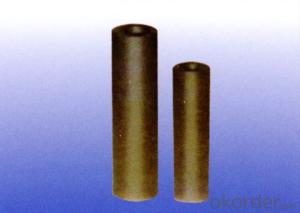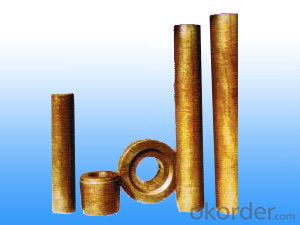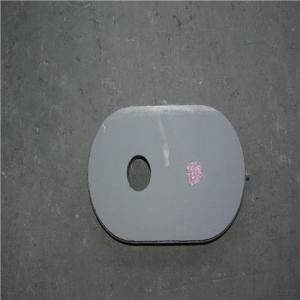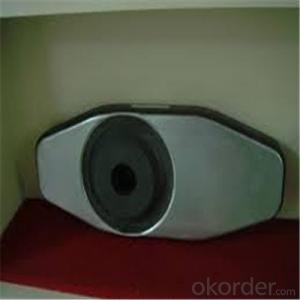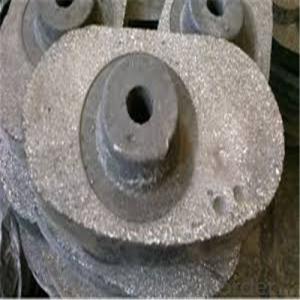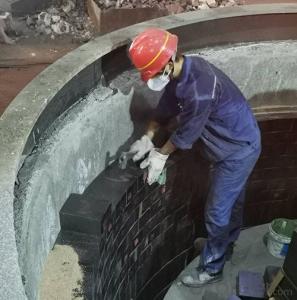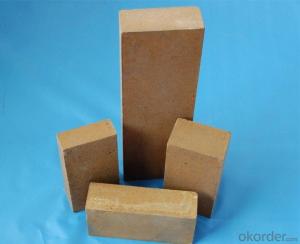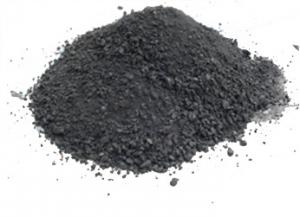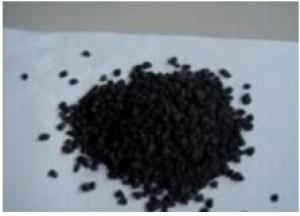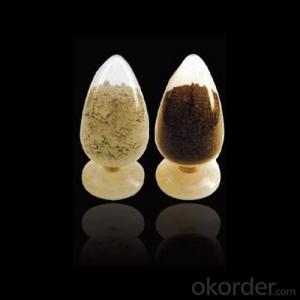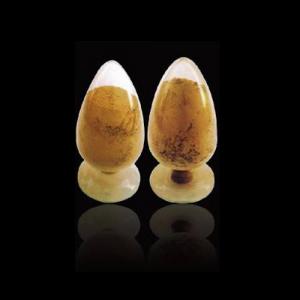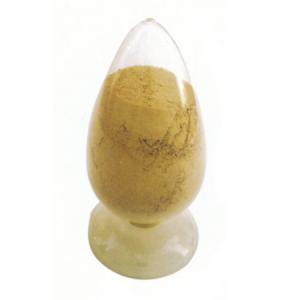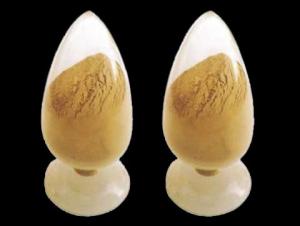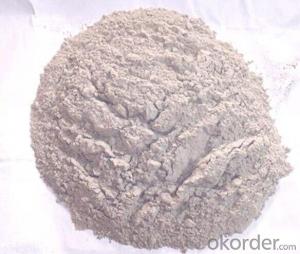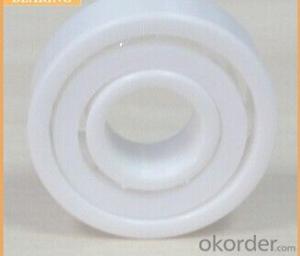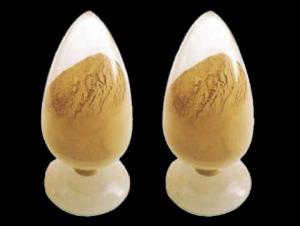Monolithic Refractories for Iron and Steel Industry:Refractory Magnesia Carbon Taphole Bricks for BOF
- Loading Port:
- Shanghai
- Payment Terms:
- TT OR LC
- Min Order Qty:
- 10 set
- Supply Capability:
- 50000 set/month
OKorder Service Pledge
OKorder Financial Service
You Might Also Like
refractory Magnesia carbon taphole bricks for bof
Application unique channel for Pouring steel water from converter
or EAF to ladle
Raw material 99% Large crystal bone material, 599 flake graphite as
binder CaB6 the additive
performance Convenient for changing and construct
Eliminate the steel water leaking from tap hole , improve the safe
ratio apparently
deduct the oxidizing secondly for the steel water
raise the quality of the steel water
much longer service life
( 200 times on converter continue working 25 hours)
Perfect thermal shock ability ,can resist the extreme cold
and hot
Dense structure ,high resistance for washing and erosion
excellent resistance for oxidizing slag and spalling
high refractoriness
Wonderful sinter ability, and adhesion
Specification:
specification | Item | Number |
Chemical | MgO | ≥78% |
C | ≥12% | |
physical | CCS | ≥30MPa |
AP | ≤ 5% | |
BD | ≥2.9g/cm3 | |
Refractoriness | 1500°C-1600°C |
Our Services
Construction To install
Packaging & Shipping
Packing inside: plastic bag
outside: wood carton for sea worthy
FAQ
Store under the room temperature.
for half a year
Pay attention to To be dry ,no hitting
- Q: How do monolithic refractories resist abrasion in the iron and steel industry?
- Monolithic refractories are specifically designed to resist abrasion in the iron and steel industry due to their unique composition and properties. These refractories are made from a single homogeneous material, which allows them to exhibit exceptional strength and durability when subjected to continuous abrasion. One of the key factors that contribute to the abrasion resistance of monolithic refractories is their high density. These refractories are manufactured with tightly packed particles, ensuring a solid and compact structure. This density helps to minimize wear and tear caused by the constant movement of materials, such as iron and steel, within the industry. Additionally, monolithic refractories often contain high levels of alumina, which is known for its excellent abrasion resistance. Alumina is a highly refractory material that can withstand high temperatures and mechanical stress without deteriorating. Its presence in monolithic refractories provides a protective layer that resists abrasion caused by the movement and impact of iron and steel particles. Moreover, monolithic refractories can be designed with specific additives and binders that further enhance their resistance to abrasion. These additives can include silicon carbide, mullite, or zirconia, which are known for their superior mechanical strength and ability to withstand wear. The binders used in the manufacturing process also contribute to the refractory's integrity and ability to withstand abrasion by providing a cohesive structure. Overall, the combination of high density, alumina content, specialized additives, and binders makes monolithic refractories highly resistant to abrasion in the iron and steel industry. These refractories are capable of withstanding the harsh conditions and constant movement of materials, ensuring longevity and efficiency in various applications within the industry.
- Q: How do monolithic refractories resist corrosion from molten metals?
- Due to their unique composition and structural properties, monolithic refractories have the ability to resist corrosion caused by molten metals. Typically made from a single material like alumina, magnesia, or silica, these refractories are specifically designed to withstand harsh chemical environments and high temperatures. A significant contributing factor to their corrosion resistance is their dense and compact structure. Through a specialized manufacturing process, monolithic refractories are created with a tightly bonded material that has minimal porosity. This low porosity prevents molten metals from penetrating the refractory and causing damage. Moreover, monolithic refractories often incorporate additives or binders to enhance their resistance to corrosion. These additives, such as silicon carbide, zirconia, or other chemically stable materials, can endure the corrosive effects of molten metals. Additionally, monolithic refractories possess excellent thermal shock resistance. This means that they can endure sudden temperature changes without cracking or spalling. When in contact with molten metals, the refractory's ability to handle thermal shock prevents the formation of cracks or fractures, which would allow further penetration of the corrosive molten metal. In conclusion, the combination of a dense structure, chemical additives, and high thermal shock resistance enables monolithic refractories to effectively resist corrosion caused by molten metals. These refractories find extensive use in various industrial applications, including steelmaking, foundries, and non-ferrous metal processing, where they offer reliable and durable protection against corrosion.
- Q: How are monolithic refractories repaired or replaced in iron and steel facilities?
- Monolithic refractories are commonly used in iron and steel facilities due to their superior thermal and mechanical properties. These refractories are designed to withstand high temperatures, thermal shocks, and chemical attacks. However, over time, they may experience wear and tear, leading to the need for repair or replacement. The repair or replacement process for monolithic refractories in iron and steel facilities generally involves the following steps: 1. Inspection: A thorough inspection of the refractory lining is conducted to identify areas that require repair or replacement. This inspection may involve visual examination, thermal imaging, or other non-destructive testing techniques to assess the extent of damage. 2. Removal of damaged material: The damaged monolithic refractory material is carefully removed using appropriate tools and equipment. This step ensures that the new refractory material will adhere properly to the substrate. 3. Surface preparation: The substrate or lining surface is prepared to enhance the bonding between the new refractory material and the existing structure. This may involve cleaning, grinding, or shot blasting to remove loose particles, contaminants, and any remaining damaged material. 4. Selection of repair material: Depending on the specific requirements and operating conditions, a suitable repair material is selected. This may involve choosing a similar monolithic refractory material or a specific repair product designed for the application. 5. Mixing and installation: The repair material is mixed according to the manufacturer's instructions, ensuring proper consistency and workability. It is then applied to the prepared surface using various techniques such as troweling, spraying, or casting. Care is taken to achieve the desired thickness and proper consolidation of the repair material. 6. Curing and drying: After installation, the repaired refractory material is allowed to cure and dry as per the manufacturer's recommendations. This step is critical to achieve the desired strength and thermal properties of the refractory lining. 7. Quality control: Once the repair or replacement is complete, quality control measures are taken to ensure the integrity and effectiveness of the repaired/refurbished refractory lining. This may involve conducting tests like thermal conductivity measurements, density checks, or visual inspections. It is important to note that the repair or replacement process for monolithic refractories may vary depending on the specific requirements and conditions of each iron and steel facility. Additionally, it is recommended to consult with refractory experts or manufacturers to ensure the correct selection of materials and proper execution of the repair or replacement procedure.
- Q: How long is the lifespan of monolithic refractories in iron and steel applications?
- The lifespan of monolithic refractories in iron and steel applications can vary depending on several factors. These factors include the type of refractory material used, the specific application, the operational conditions, and the maintenance practices implemented. In general, monolithic refractories used in iron and steel applications are designed to withstand high temperatures, thermal shock, chemical attack, and mechanical stress. They are expected to have a relatively long lifespan compared to other refractory materials. Under normal operating conditions and proper maintenance, monolithic refractories can typically last anywhere from several months to several years in iron and steel applications. However, it is important to note that certain areas of the application may experience more severe conditions and may require more frequent repairs or replacements. Regular inspections and monitoring of the refractories' condition are crucial to identify any signs of deterioration or damage. Any necessary repairs or replacements should be carried out promptly to prevent further damage and minimize downtime. It is also worth mentioning that advancements in refractory technology and materials have led to the development of more durable and long-lasting monolithic refractories. These advancements have increased the lifespan of refractories in iron and steel applications, ultimately improving the overall efficiency and productivity of the operations.
- Q: What are the considerations for repairing and relining monolithic refractories?
- When repairing and relining monolithic refractories, there are several important factors to take into account. Firstly, it is crucial to evaluate the level of damage or wear on the refractory lining. This can be achieved through visual inspection or non-destructive testing methods like ultrasonic or thermal imaging. By determining the severity and location of the damage, the appropriate repair or relining technique can be selected. Another aspect to consider is the type of monolithic refractory material being used. Different materials have varying properties and performance characteristics, which must be considered when choosing a repair method. For instance, certain materials may require specialized equipment or high-temperature curing during installation. The operational conditions of the refractory lining also play a significant role. Factors such as temperature, chemical exposure, and mechanical stress can impact the performance and durability of the lining. Therefore, it is essential to select a repair or relining method that can withstand these conditions and provide long-lasting protection. Furthermore, the downtime and cost implications of the repair or relining process need to be taken into account. Some methods may involve longer curing or drying times, resulting in extended shutdown periods. It is important to carefully evaluate the benefits of the repair or relining against the potential production losses and expenses associated with the downtime. Lastly, adhering to industry standards and guidelines is of utmost importance when repairing or relining monolithic refractories. This ensures that the repairs are executed correctly and safely, minimizing the risk of future damage or failure. Seeking advice from refractory experts or manufacturers can provide valuable insights and guidance in this regard. To summarize, the considerations for repairing and relining monolithic refractories encompass assessing the extent of damage, understanding the properties of the refractory material, considering the operating conditions, evaluating downtime and cost implications, and following industry standards and guidelines.
- Q: How do monolithic refractories withstand mechanical stress in the iron and steel industry?
- Monolithic refractories are designed to withstand mechanical stress in the iron and steel industry through their unique composition and properties. These refractories are made up of a single, uniform structure, as opposed to traditional brick-like refractories that consist of multiple pieces. This monolithic structure provides several advantages in terms of mechanical stress resistance. Firstly, monolithic refractories possess a higher strength and density compared to traditional refractories. This allows them to better withstand the mechanical forces exerted during various processes in the iron and steel industry, such as the movement of molten metal, the impact of scrap materials, or the pressure from gases and liquids. Their superior strength and density help prevent cracking, deformation, or failure under these stress conditions. Additionally, monolithic refractories offer excellent thermal shock resistance, which is crucial in the iron and steel industry. The rapid heating and cooling cycles experienced in processes like steelmaking or iron casting can cause thermal stress on refractories. However, the monolithic structure of these refractories allows for better thermal conductivity and expansion, reducing the risk of thermal shock damage. This ability to withstand thermal stress contributes to their overall mechanical stress resistance. Moreover, monolithic refractories can be customized and applied on-site, providing a seamless lining that eliminates joints or weak spots. This seamless application ensures a more uniform distribution of stress and prevents the formation of cracks or gaps that could weaken the refractory lining. By eliminating these vulnerabilities, monolithic refractories enhance their ability to resist mechanical stress in the demanding conditions of the iron and steel industry. In conclusion, monolithic refractories withstand mechanical stress in the iron and steel industry through their high strength and density, superior thermal shock resistance, and seamless application. These properties enable them to endure the intense mechanical forces encountered during various processes, ensuring the longevity and efficiency of refractory linings in this demanding industry.
- Q: How do monolithic refractories resist chemical attack from molten metals and slags?
- Monolithic refractories are designed to resist chemical attack from molten metals and slags through a combination of factors. Firstly, monolithic refractories are typically made from high-quality materials that have excellent chemical resistance properties. These materials, such as alumina, magnesia, or silica, have a stable chemical structure that can withstand the corrosive nature of molten metals and slags. Secondly, monolithic refractories are often formulated with additives or binders that enhance their resistance to chemical attack. These additives can improve the refractory's ability to form a protective layer on its surface, which acts as a barrier between the refractory material and the corrosive molten metal or slag. Additionally, monolithic refractories are often designed with a dense microstructure that limits the penetration of molten metals and slags. The dense structure minimizes the pathways through which corrosive agents can reach the refractory material, reducing the risk of chemical attack. Moreover, monolithic refractories can be installed with proper joint design and anchoring systems to prevent the infiltration of corrosive substances. This ensures that the refractory lining remains intact and effectively resists chemical attack. Overall, the combination of high-quality materials, additives, dense microstructure, and proper installation techniques contribute to the ability of monolithic refractories to resist chemical attack from molten metals and slags, thereby extending their lifespan and maintaining the integrity of the refractory lining in high-temperature applications.
- Q: How do monolithic refractories withstand thermal shock?
- Monolithic refractories possess unique properties and composition that enable them to endure thermal shock. Thermal shock occurs when there is a sudden alteration in temperature, leading to stress and potential damage to the refractory material. However, monolithic refractories are constructed to possess high resistance to thermal shock, and this is accomplished through various mechanisms. Firstly, the composition of monolithic refractories incorporates materials with low coefficients of thermal expansion. This implies that they undergo minimal alterations in size or volume when exposed to varying temperatures. This characteristic allows the refractory material to withstand thermal shock by minimizing the stress caused by temperature fluctuations. Secondly, monolithic refractories exhibit exceptional thermal conductivity. This quality enables them to efficiently transfer heat away from the hot regions, preventing localized overheating and diminishing the likelihood of thermal shock. The rapid dissipation of heat aids in maintaining a more even distribution of temperature within the refractory material, thereby reducing the chances of cracking or spalling. Furthermore, the binding agents employed in monolithic refractories play a vital role in enhancing their resistance to thermal shock. These binders provide strength to the refractory material and assist in preserving its integrity during thermal cycling. Additionally, the binders contribute to the refractory's ability to withstand thermal shock by reducing the permeability of the material, thus preventing the infiltration of hot gases or liquids that could cause damage. Moreover, the installation technique of monolithic refractories plays a significant role in their capacity to endure thermal shock. Typically, monolithic refractories are applied as a single, uninterrupted layer, eliminating the weak points such as joints and seams that exist in other refractory systems. This seamless installation method ensures superior resistance to thermal shock as there are no vulnerable points for cracks to propagate. In conclusion, monolithic refractories effectively withstand thermal shock through a combination of factors including their low coefficients of thermal expansion, high thermal conductivity, appropriate binding agents, and seamless installation techniques. These properties and design considerations enable monolithic refractories to proficiently handle rapid temperature changes and maintain their structural integrity, making them ideal for applications involving thermal cycling and extreme variations in temperature.
- Q: How are monolithic refractories different from traditional refractory materials?
- Monolithic refractories are different from traditional refractory materials in several ways. Firstly, while traditional refractory materials are typically made from bricks, blocks, or tiles, monolithic refractories are composed of a single, continuous material. This means that they do not have any joints or seams, which can be a weak point in traditional refractory structures. Secondly, monolithic refractories are much easier to install compared to traditional refractory materials. They can be easily shaped and applied in situ, allowing for greater flexibility in design and construction. In contrast, traditional refractory materials require skilled labor and more time-consuming installation methods such as bricklaying. Furthermore, monolithic refractories offer improved thermal shock resistance. Due to their continuous structure, they can better withstand sudden changes in temperature without cracking or spalling. Traditional refractory materials, on the other hand, may be more susceptible to thermal shock damage. Another advantage of monolithic refractories is their ability to provide better insulation. Their composition often includes lightweight aggregates or insulating fibers, which help to reduce heat loss and improve energy efficiency. Traditional refractory materials, while still capable of providing insulation, may not offer the same level of thermal efficiency. Lastly, monolithic refractories have the advantage of being more cost-effective. Their ease of installation, reduced labor requirements, and improved thermal performance contribute to lower overall project costs compared to traditional refractory materials. In summary, monolithic refractories differ from traditional refractory materials in terms of their continuous structure, ease of installation, improved thermal shock resistance, better insulation properties, and cost-effectiveness. These characteristics make them a preferred choice in many industries where high-temperature applications and thermal insulation are required.
- Q: What are the common challenges faced by monolithic refractories in the iron and steel industry?
- The iron and steel industry heavily relies on monolithic refractories, which have a vital role in various applications like lining furnaces, ladles, and tundishes. However, these materials encounter common challenges in this industry. Thermal shock is a major challenge. Monolithic refractories undergo extreme temperature changes, especially during start-up and shut-down phases. This rapid heating and cooling can cause thermal stress, leading to cracking and spalling. To combat this, refractory manufacturers create high-quality monolithic materials with enhanced thermal shock resistance. Corrosion is another significant challenge. The iron and steel industry exposes refractory linings to aggressive materials like molten metal, slag, and gases, which chemically attack them. This corrosion results in material degradation, erosion, and reduced service life. To address this, specialized monolithic refractories with excellent corrosion resistance are used, often containing additives that can withstand the corrosive environment. Abrasion is also a common challenge faced by monolithic refractories in this industry. The movement of raw materials, molten metal, and slag causes mechanical wear on the refractory lining, leading to material loss and compromised performance. Refractory manufacturers develop abrasion-resistant monolithic materials that can withstand intense wear and tear, ensuring extended service life. Moreover, good thermal conductivity is often required in the iron and steel industry. This is crucial for efficient heat transfer and maintaining optimal operating conditions. Achieving the right balance between thermal conductivity and mechanical strength can be challenging, as refractories with high thermal conductivity often have lower mechanical strength. Therefore, selecting the appropriate monolithic refractory with desired thermal conductivity properties is crucial for optimal performance. Lastly, installation and maintenance present challenges for monolithic refractories. The application of these refractories requires skilled personnel and careful installation techniques due to their liquid or semi-liquid nature. Additionally, regular maintenance and repairs are necessary to ensure the refractory lining's longevity and performance. Regular inspections, repairs, and proper curing techniques are vital to mitigate these challenges and optimize refractory performance. In conclusion, monolithic refractories in the iron and steel industry face challenges such as thermal shock, corrosion, abrasion, thermal conductivity, and installation/maintenance. Addressing these challenges through the development of specialized refractory materials and employing proper installation and maintenance techniques are crucial for ensuring efficient and reliable performance in this demanding industry.
Send your message to us
Monolithic Refractories for Iron and Steel Industry:Refractory Magnesia Carbon Taphole Bricks for BOF
- Loading Port:
- Shanghai
- Payment Terms:
- TT OR LC
- Min Order Qty:
- 10 set
- Supply Capability:
- 50000 set/month
OKorder Service Pledge
OKorder Financial Service
Similar products
Hot products
Hot Searches
Related keywords
